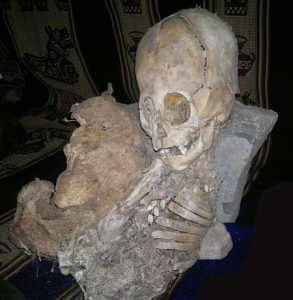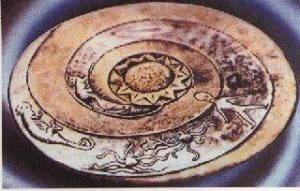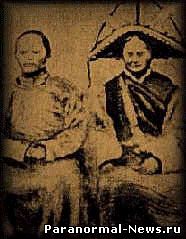
Stone Drops (1.)
 10
10
 08. 02. 2017
08. 02. 2017

Discover Drop
We wrote the disc discovery earlier.
They were discovered in 1937 (some sources state the year 1938) by the Chinese archaeologist Zhichu Teji in the Bajan-har-shan Mountains, in northern Tibet. They were then forgotten in the archives for 20 years before being encountered by another Chinese professor, Tsum Um Nui.
At the site of the find was a burial ground, where there were 716 skeletons of humanoid creatures up to 120 cm high and, due to the small body, with a relatively large and elongated skull.
At each skeleton was a thin stone disk, up to 1 cm thick and about 30 cm in diameter, with a circular hole in the middle, from which two spiral grooves protruded to the edges of the disk. There were unknown characters on the sides of the grooves, similar to hieroglyphs and not even remotely resembling the Chinese script. Professor Tsum Um Nui began intensive research, trying to find the key to deciphering the mysterious inscriptions.
In the early 60s, several disks were sent for analysis and determination of age at the Academy of Sciences in Moscow, and were set at 12 years, which corresponded to the age of skeletal remains. To great surprise, it was found that the discs are not pure stone, but also contain a considerable admixture of cobalt and other metals. In Moscow, they also underwent an oscilloscope test and again could not believe their eyes. The device measured large vibrations, which could mean that the disks were once exposed to a strong electric charge. An article on disk analysis was then published by academician Vyacheslav Zajcev in the Sputnik magazine, and that ended it all in the former USSR.
In 1962, Professor Tsum Um Nui announced that he had succeeded in deciphering the mysterious inscriptions that told of the arrival of visitors to Earth. They were to arrive from a distant planet in the star system of Syria. The spacecraft of the newcomers suffered damage and there was an emergency landing in the mountainous area. The then inhabitants of Kham were scattered in horror. There is a reference in the legends that the foreigners were repulsively ugly and the locals tried to exterminate them. In the end, the castaways managed to make contact and explain that he was coming in peace.
When the newcomers inspected the damage to their ship, it was clear to them that they were irreparable and would have to stay and adapt to life on Earth. They gradually passed on some knowledge to the locals and lost it themselves over the millennia.
Tsum Um Nui published the results of his work, but did not receive recognition, quite the contrary. He summoned a wave of hostile criticism. The disappointed and disgusted professor managed to go to Japan before the outbreak of the Chinese Cultural Revolution, where he wrote his findings and wanted to publish them in book form, the result was the same as in China. Readers never saw the book. Professor Tsum distributed several copies of the manuscript to his friends from professional circles, and thanks to that, his work did not fall into complete oblivion. He died in 1965.
His book aroused great interest in Western Europe and attracted many researchers. At that time, however, the cards were significantly shuffled by the Cultural Revolution (1966 - 1976) and most of the discs mysteriously "lost". But some Western researchers have not given up.
People Drop
The first to try to decipher, however, was the Englishman Karyl Robin-Evans in 1947, who, after a long search, found not only a place to land, but also an entire tribe called Dzopa (Dropa) and lived with them for about half a year.
This begs the question of how he learned of the incident when a Chinese professor did not publish his work until 1962. Robin-Evans met with Polish scientist Sergei Lolladoff, who showed him a stone disk with two spiral arms and told how he had obtained it. He bought it on his travels in northern India from a man named Dzopa, and he shared with him a story that was tied to the disk. Karyl's story and disc were very interesting. This artifact is known as the Lolladoff Plate.
The leader of the tribe was Lurgan-La at the time, and he told Robin-Evans that his ancestors had visited Earth twice. The first time 20 years ago, when they returned safely to their home planet, the ship sank for the second time, and the aliens had no choice but to stay on Earth. Lurgan-La told him that the people of his tribe were the direct descendants of visitors who came from the Sirian system.
Here is another question, the offspring of the Big Dog's constellation are also considered to be the African tribe of Dogon in Mali, who orally passes on his knowledge and knew about spiral galaxies earlier than modern scientists.
It is possible (and probable) that the ancestors of the Drops landed on Earth before those who were the ancestors of the Dogons. Perhaps that is why the knowledge of the tribe in Mali is much more "preserved" than that found in the legends of the East.
The height of the members of the tribe did not exceed 120 cm. Karyl Robin-Evans described his experiences in his notes, and on the basis of them a book was published, in 1978 (4 years after his death), Sungods in Exile: secrets of the Dzopa of Tibet, author David Gamon. It should be noted that Gamon denied the authenticity of the story in 1995, inspired by the growing popularity of Erich von Dänik. Which doesn't mean it couldn't be true…
In the 90s, another expedition stayed in the same places, but did not find the people of Dropa. Instead, she came across interesting murals and engraved figures in the surrounding caves, which had already been seen by Zhich Tchai, the discoverer of skeletal remains and disks. It shows the solar system and the star system of Syria, from where small dots led to the "us". The arc arc avoided the Sun, and the dots ended near the blue planet. The researchers concluded that the aliens had seen the trajectory of their flight to Earth. The age of the image was estimated at more than 10 years.








